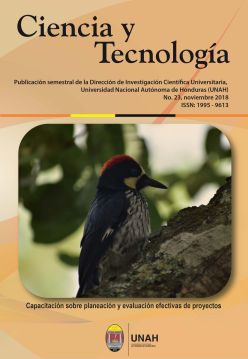Implementation of a PCR-RFLP / Hsp70 to identify and typify Leishmania species in an area endemic to Leishmaniasis Atypical Cutaneous in Honduras
DOI:
https://doi.org/10.5377/rct.v0i23.6862Abstract
Introduction. The atypical cutaneous leishmaniasis is a non-ulcerated variant of the cutaneous leishmaniasis produced by Leishmania (L.) infantum. In Honduras, it is present in the departments of La Paz, Francisco Morazán, Choluteca, El Paraíso, and Valle. The clinical spectrum includes from cutaneous lesions smaller than 10 mm and benign, thru visceral affections tan can compromise the patient’s life. The objective of the present study was to implement the molecular biology technique for the detection and typing of the Leishmania spp in individuals with suspected atypical cutaneous leishmaniasis lesions. Methodology. For the implementation, reference strain DNA was used: Leishmania (L.) infantum chagasi, leishmania (L.) mexicana, Leishmania (V.) panamensis, Leishmania (V.) braziliensis with an expected product of 1200 base pairs (pb). Hae III, BccI, RsaI, and Mlul restriction enzymes were used for the Leishmania gender specie identification. Film smear clinical samples were selected from departments of Francisco Morazán and Valle. The study was submitted to the Ethics Committee of the Master of Infectious and Zoonotic Diseases. Results: 39 samples were analized (27 from Francisco Morazán and 12 from Valle). Leishmania (L.) infantum was identified in the 100% of the samples (29/29). Conclusions/Recommendations: It was demonstrated that the polimorphism of the hsp70 gene, together with the enzymatic digestion (RFLP) provides good results in the parasite amplification from film smear samples, expediting the molecular identification, being a very useful tool for the Leishmania spp specie typication in areas where this parasite is more prevalent. It is recommended to make a constant epidemiological surveillance to determine the Leishmania specie geographical behavior.
Downloads
1461
Downloads
Published
How to Cite
Issue
Section
License
© Revista Ciencia y Tecnología
Authors who publish in this journal accept the following conditions: In accordance with the legislation of copyright, Revista Ciencia y Tecnología, recognizes and respects the moral right of authors, as well as the ownership of the patrimonial right, which will be ceded to the magazine for its diffusion in open access in printed version and in digital format. By being part of multiple indexers, databases and reference systems, the articles published by Revista Ciencia y Tecnología will be visible and will be downloaded from these websites, indicating, in all cases, the authorship of the articles, the date of publication and the number of the journal to which they correspond.




